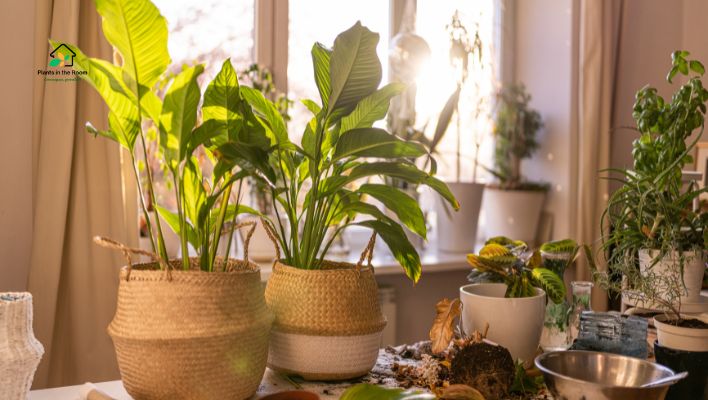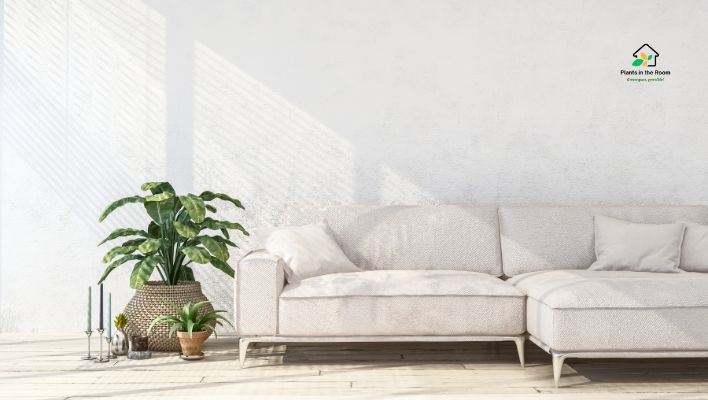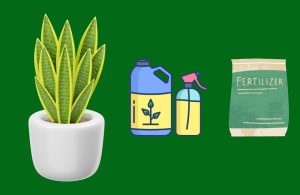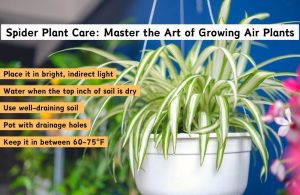This article covers the following areas –
- Choosing the Right Variety for Indoor Cultivation
- Ideal Location for Your Indoor Banana Plant
- Proper Planting and Potting for Your Indoor Banana Plant
- Watering Your Indoor Banana Plants for Optimal Growth
- Fertilizer Recommendations for Optimal Growth
- Pruning and Other Maintenance of Your Banana Plants
- Propagation and Repotting of Indoor Banana Plants
- Other Common Issues to Consider Seriously
- In Conclusion
- Get to Know Your Banana Plant
Banana plants have become increasingly popular as indoor plants, and it’s no surprise why. With their lush, tropical foliage and the possibility of fruit production, they bring an exotic touch to any home. To help your indoor banana plant thrive, it’s essential to provide proper care. This comprehensive guide will walk you through everything you need to know as an indoor plant lover.
Indoor banana plant care involves bright, indirect sunlight for 6-8 hrs/day, consistent temperature (65-85°F/18-29°C), 50%+ humidity, and well-draining soil. Water when the top 1-2″ of soil is dry. Fertilize with a balanced, slow-release formula every 4-6 weeks during the growing season.
I’ve got a lot of tips to share about indoor banana plant care. Keep reading this post to learn more about nurturing your indoor banana plant to ensure its optimal growth and health.
Choosing the Right Variety for Indoor Cultivation
Growing banana plants indoors can be a rewarding experience, as it brings a touch of the tropics to your living space. However, selecting the appropriate variety of banana plants is crucial to ensure its success in an indoor environment.
As a plant lover, you should consider different factors when choosing a banana plant for your home. Here, I’ll talk about the characteristics of different banana plant varieties and provide essential tips for selecting the perfect indoor banana plant.
Dwarf Varieties That Are Suitable for Indoors
Banana plants come in numerous varieties, but not all are well-suited for indoor cultivation. For indoor environments, dwarf varieties are the top choice, as they are compact and more manageable in size. Some popular dwarf varieties that thrive indoors are mentioned below.
#1 Dwarf Cavendish
Dwarf Cavendish is a popular choice among indoor gardeners due to its manageable size, typically reaching 4-6 feet in height. Dwarf Cavendish plants can produce fruit, even indoors, under the right conditions.
#2 Super Dwarf Cavendish
Super Dwarf Cavendish is an even more compact variety as it reaches only 2-4 feet in height. This plant is perfect for smaller spaces or for those who desire a more petite banana plant. Although fruit production is less likely, it’s still possible with optimal care.
#3 Dwarf Red
The Dwarf Red banana plant is known for its striking red-tinged leaves and can reach 6-8 feet in height. While it may require more space, the Dwarf Red adds a unique touch to any indoor garden.
Consider the Space and Growth Rate of Banana Plant
Before choosing a banana plant, it’s essential to consider the available space in your home and the plant’s potential growth rate. Some varieties grow faster and larger than others, which may not be ideal for those with limited space.
Determine the amount of space you can dedicate to your banana plant. Keep in mind that these plants need ample room for their foliage to spread out. Also, consider the height of your ceilings, as some varieties can grow quite tall.
Some banana plants grow faster than others, which can impact the frequency of repotting and pruning. Choose a variety with a growth rate that suits your maintenance preferences and available time for plant care.
Ideal Location for Your Indoor Banana Plant

As a plant enthusiast, you know that providing the right environment for your indoor plants is essential for their health and growth. When it comes to banana plants, selecting the perfect location within your home can make all the difference in helping your tropical plant thrive. By understanding and meeting the environmental needs of your plant, you can create a lush, vibrant tropical oasis in your home.
A. Light Requirements
One of the most crucial aspects of caring for your indoor banana plant is providing it with the right amount of light. With the proper light conditions, your indoor banana plant will flourish, providing you with a lush, tropical atmosphere in your living space.
a) Amount of Sunlight Needed
Banana plants are sun-loving plants that require at least 6-8 hours of bright, indirect light per day to thrive. Although they can tolerate some direct sunlight, excessive exposure may cause their leaves to scorch, leading to an unhealthy plant.
b) Best Placement Within Your Home
To provide the necessary light for your banana plant, position it near a large window or a sunroom with ample sunlight. East or west-facing windows are ideal for offering the right balance of light, but south-facing windows can also work well if the light is filtered to prevent excessive direct sunlight. Make sure to rotate your plant regularly to ensure even exposure and growth.
B. Temperature and Humidity Preferences
To keep your indoor banana plant healthy and vibrant, it’s essential to recreate the tropical conditions it naturally thrives in. By closely mimicking their native environment, you can enjoy the lush, tropical presence of your indoor banana plant and ensure its continued health and growth.
a) Ideal Temperature Range
Banana plants, being native to tropical regions, prefer a consistent temperature range between 65-85°F (18-29°C). Sudden temperature fluctuations can harm your plant, so it’s important to avoid placing it near drafts, air vents, or heating and cooling units.
b) Humidity Levels & Tips to Maintain Banana Plants
To mimic the natural humidity levels of their tropical habitat, banana plants need a humidity level of 50% or higher. Maintaining proper humidity is crucial for the plant’s overall health and can prevent issues such as leaf browning or curling. Here are some tips for maintaining the desired humidity for your banana plant:
- Use a humidifier to increase the humidity around your plant, particularly during the dry winter months or in arid climates.
- Create a humidity tray by placing a shallow tray filled with water and pebbles beneath your plant’s container, ensuring the pot doesn’t sit directly in the water to avoid root rot.
- Group your banana plant with other humidity-loving plants to create a microclimate of increased humidity.
- Regularly mist your plant’s leaves with water, but be cautious of over-misting, as it can lead to fungal issues.
By finding the ideal location for your indoor banana plant and addressing its light, temperature, and humidity needs, you’ll be well on your way to nurturing a stunning and healthy tropical plant. With the right environment, your indoor banana plant will reward you with lush, vibrant foliage and, possibly, even fruit.
Proper Planting and Potting for Your Indoor Banana Plant

The journey to a thriving indoor banana plant begins with proper planting and potting techniques. Ensuring that your plant has the right foundation is key to healthy growth and preventing issues like root rot or instability. By following these guidelines, you can create a nurturing environment that sets your plant up for success and allows it to flourish in your home.
Choosing the Right Container Size and Material
The container you choose for your banana plant plays a significant role in its overall health and well-being. Here are some factors to consider when selecting a container.
- Size: Choose a container that is slightly larger than the root ball of your plant, allowing enough room for the roots to grow and develop. A pot that is too small can lead to root-bound plants, while an excessively large pot can hold too much moisture and cause root rot.
- Drainage: Ample drainage is crucial for banana plants, as they are sensitive to overwatering. Ensure that your container has multiple drainage holes at the bottom to allow excess water to escape and prevent waterlogged soil.
- Material: Select a heavy, sturdy material, such as ceramic or terracotta, for your plant’s container. These materials provide stability and help prevent the plant from toppling over as it grows.
Appropriate Soil Mix and Drainage
The right soil mix is essential for the health of your indoor banana plant, as it provides the necessary nutrients, aeration, and drainage for the plant’s roots. Keep these points in mind when preparing the soil for your banana plant.
- Soil mix: Use a high-quality, well-draining potting mix as the base for your banana plant. Look for mixes specifically designed for tropical plants, as these often contain the right balance of nutrients and drainage properties.
- Improving drainage: To enhance the drainage of your potting mix, add perlite or vermiculite to the soil. These amendments improve aeration and prevent the soil from becoming too compact, which can lead to root rot and other issues.
Watering Your Indoor Banana Plants for Optimal Growth
Proper watering is crucial to the overall health and well-being of your indoor banana plant. By following these recommendations, you can provide the optimal care needed for your banana plant to flourish in your home.
Maintain a Watering Schedule
Both overwatering and underwatering can lead to various issues. So, you should tailor your watering schedule accordingly. By watering your banana plant appropriately, you can keep it well-hydrated and help it thrive in your indoor space.
Signs of Overwatering & Underwatering
Overwatered plants may display yellowing leaves, root rot, and a musty smell, while underwatered plants can exhibit wilting, curling, and browning leaves. To avoid these issues, water your plant when the top 1-2 inches of soil feel dry to the touch.
Adjusting Watering Based on Seasons & Plant Size
Banana plants’ water requirements can vary depending on the season and their size. During the growing season (spring and summer), they need more frequent watering, while in the dormant season (winter), you should reduce watering. Additionally, larger plants may require more water than smaller ones, so adjust your watering schedule accordingly.
Fertilizer Recommendations for Optimal Growth
Using the proper type of fertilizer and applying it at the right frequency can make all the difference in the appearance and productivity of your plant. By following these recommendations, you can ensure that your indoor banana plant receives the nourishment it needs to flourish and bring a tropical touch to your home.
Type of Fertilizer to Use
To support the growth and development of your indoor banana plant, use a balanced, slow-release fertilizer with equal proportions of nitrogen, phosphorus, and potassium, such as a 10-10-10 or 14-14-14 formula. These fertilizers provide essential nutrients that promote lush foliage and overall plant health.
Application Frequency & Amount of Fertilizer
Fertilize your banana plant every 4-6 weeks during the growing season to provide the necessary nutrients for optimal growth. Follow the manufacturer’s instructions for the appropriate amount and method of application.
During the winter months, when your plant is dormant or growing more slowly, reduce fertilization to prevent overfeeding and potential damage to your plant.
Pruning and Other Maintenance of Your Banana Plants
Regular pruning and maintenance are essential for ensuring the longevity and vitality of your indoor banana plant. These practices not only help your plant maintain its desired shape and appearance but also contribute to its overall health by preventing pests and promoting robust growth.
A. When to Prune Your Indoor Banana Plant
Pruning your indoor banana plant is necessary to remove dead or yellowing leaves and encourage healthy growth. Regularly inspect your plant for any leaves that are damaged, discolored, or wilted, and prune them as needed. Also, you can trim back overly long leaves to maintain the desired shape and size of your plant, ensuring it remains visually appealing and well-suited for your space.
B. Proper Pruning Techniques for Healthy Growth
To maintain your plant’s health and minimize the risk of infection, follow these pruning techniques.
- Use clean, sharp tools: Utilize clean, sharp pruning shears or scissors to make clean cuts at the base of the leaf stem. This reduces the risk of disease transmission and helps the plant heal more quickly.
- Wear gloves: Banana plant sap can cause skin irritation, so it’s essential to wear gloves when pruning to protect your hands.
- Sanitize your tools: Before and after pruning, sanitize your cutting tools with rubbing alcohol or a diluted bleach solution to prevent the spread of pathogens.
C. Pest Prevention and Management
Indoor banana plants can sometimes fall victim to pests, which can cause damage to the plant and hamper its growth. As a responsible plant owner, it’s vital to monitor your plant’s health and be proactive in addressing any potential pest issues.
By regularly checking your plant, applying appropriate treatments, and maintaining preventative measures are crucial to ensure your indoor banana plant remains healthy and pest-free. By taking these necessary steps, you can preserve the beauty and vitality of your banana plant, allowing it to continue bringing a tropical touch to your home.
Common Pests & Signs of Infestation
Indoor banana plants can be susceptible to pests such as spider mites, mealybugs, and aphids. Signs of infestation may include discolored or curling leaves, a sticky residue on the plant’s leaves, or visible pests crawling on the plant.
Effective Treatment Methods
If you notice an infestation, take prompt action to manage and prevent the spread of pests.
- Physical removal: Use a strong spray of water to dislodge pests from your plant or gently wipe them off with a soft cloth.
- Insecticidal soap or neem oil: Treat the infestation with insecticidal soap or neem oil, following the manufacturer’s instructions for proper application and dosage. These treatments can be effective in controlling pests without causing harm to your plant.
- Monitor and repeat treatment: Keep a close eye on your plant and repeat treatments as needed until the infestation is under control. It’s crucial to remain vigilant and proactive in pest management to prevent future outbreaks.
Propagation and Repotting of Indoor Banana Plants
Propagation and repotting are important aspects of indoor banana plant care that can ensure the continued growth and vitality of your plant while also allowing you to multiply your collection.
By propagating new plants from your existing ones and repotting when necessary, you can keep your indoor banana plants thriving and enjoy their lush, tropical presence for years to come.
A. Methods for Propagating Your Banana Plants
Banana plants can be propagated through two primary methods: division and using suckers. Here’s how to propagate your plant using these techniques:
#1 Division
Step 1: Gently remove your banana plant from its container and locate a healthy offshoot with its own roots.
Step 2: Carefully separate the offshoot from the parent plant, making sure to preserve its roots.
Step 3: Plant the new division in a separate container filled with well-draining soil and provide proper care, such as watering and fertilizing.
#2 Suckers
Suckers are small offshoots that grow around the base of the parent plant. To propagate using suckers, follow these steps.
Step 1: Carefully remove one with its roots, ensuring not to damage the parent plant in the process.
Step 2: Plant the sucker in a separate container with well-draining soil and provide the necessary care for optimal growth.
B. When and How to Repot Your Plant?
Repotting is an essential part of banana plant care that promotes healthy root development and provides the necessary space for your plant to grow. Here’s when and how to repot your banana plant:
When to Repot?
Repot your banana plant every 1-2 years or when it becomes root-bound, which is indicated by roots circling the container or growing out of the drainage holes.
How to Repot?
Step 1: Gently remove it from its container, taking care not to damage the roots.
Step 2: Inspect the root system and trim any damaged or circling roots to promote healthy growth.
Step 3: Place the plant in a slightly larger pot with fresh, well-draining soil, making sure to position it at the same depth it was previously growing.
Other Common Issues to Consider Seriously
Despite your best efforts to care for your indoor banana plant, it may occasionally experience issues that can affect its health and appearance. Being able to identify and address these common problems is essential for maintaining a thriving, attractive plant.
A. Yellowing Leaves and Their Causes
Yellowing leaves can be a common issue with indoor banana plants, and they can result from several factors. To address this problem, assess your care routine and make the necessary adjustments.
- Overwatering: If you’re overwatering your plant, reduce the frequency and ensure the pot has proper drainage to prevent root rot.
- Underwatering: If underwatering is the issue, increase the frequency and amount of water to provide sufficient hydration.
- Insufficient light: If your plant isn’t receiving enough light, move it to a brighter location with at least 6-8 hours of bright, indirect sunlight.
B. Slow Growth or No Fruit Production
Slow growth or a lack of fruit production can be frustrating for indoor banana plant owners. These issues may result from the following issues.
- Insufficient light: Ensure your plant is placed near a large window or in a sunroom that receives ample sunlight. East or west-facing windows are ideal.
- Inadequate fertilization: Fertilize your plant every 4-6 weeks during the growing season with a balanced, slow-release fertilizer to provide the necessary nutrients for optimal growth and fruit production.
C. Other Potential Problems and Solutions
Other issues, such as leaf spots, may indicate a fungal infection. To address this problem, make sure you take the folowing corrective measures.
- Fungicide treatment: Treat the affected leaves with a fungicide, following the manufacturer’s instructions for proper application and dosage.
- Improve air circulation: Enhance air circulation around your plant by ensuring it has enough space and is not overcrowded by other plants or objects. Good air circulation can help prevent the spread of fungal infections.
In Conclusion
With the right care, your indoor banana plant can thrive and become a beautiful focal point in your home. Follow the essential care tips provided in this guide, and you’ll be well on your way to enjoying a lush, vibrant banana plant that may even reward you with fruit! Embrace the rewarding experience and watch your tropical oasis come to life.
Get to Know Your Banana Plant
| Indicator | Indoor Banana Plant |
|---|---|
| Family | Musaceae |
| Genus | Musa |
| Species | Various (Dwarf varieties suitable for indoors) |
| Common Name | Indoor Banana Plant |
| Origin | Southeast Asia, South Asia |
| Plant Type | Perennial, Indoor Plant |
| Mature Size | 2-10 feet in height (depending on the variety) |
| Growth Rate | Fast |
| Light Requirements | Bright, indirect sunlight |
| Watering Requirements | Moderate, keep soil evenly moist |
| Soil Preference | Well-draining soil, such as a mix of potting mix, perlite, and vermiculite |
| pH Preference | 5.5-7.0 (Slightly acidic to neutral) |
| Temperature Tolerance | 65-85°F (18-29°C) |
| Humidity Tolerance | High humidity, around 50% or higher |
| Fertilization | Balanced fertilizer every 4-6 weeks during the growing season |
| Propagation | Division of suckers or offshoots |
| Pests | Spider mites, mealybugs, aphids |
| Diseases | Root rot, leaf spots |
| Toxicity | Non-toxic to humans and pets |
| Special Features | Attractive foliage, potential fruit production |
| Popular Uses | Indoor houseplant, sunrooms, patios |






